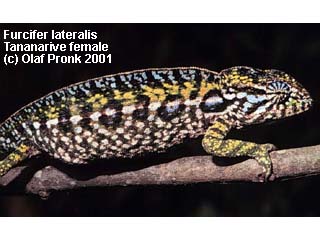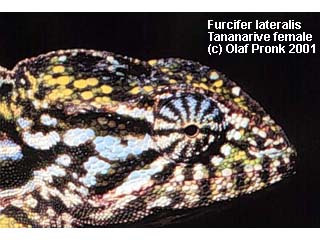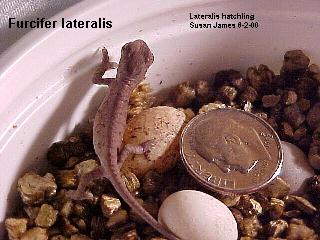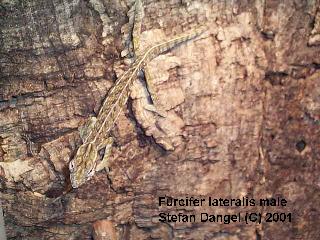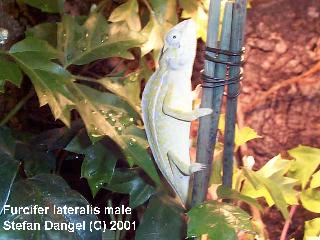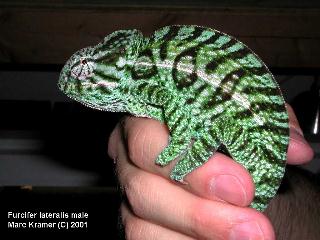F. lateralis (not to be confused with F. campani, which may also be referred to as the Jewel Chameleon) is a small chameleon (7.5"-10" TL and SVL to 5.5"), locally abundant across much of Madagascar except for the north and northwest. It inhabits wet savannahs and both dry and humid forests as well as agricultural lands. Considerable disagreement seems to exist with regard to the status of a forma major. Most authorities consider this larger form as a subspecies (F. lateralis major, q.v.) while others regard it as merely a geographical race. There even exists a minority opinion for species status (i.e., .F. major; Necas, 1999).
The low casque bears a sharp parietal crest but lacks occipital lobes. The relatively homogeneous scalation gives a smooth velvety texture. There are small dorsal, ventral and gular crests made of small, specialized, conical scales. No subspecies are known but there is considerable variability in size and color found among the various populations and habitats. Distinct color morphs have been suggested with blue-green morphs occupying humid regions with substantial rainfall and brown morphs inhabiting dry, arid regions. This morph distinction is most applicable to males. Ground colors consist of gray, brown and green. Coloration is striking with a highly complex mosaic patterning. The body markings are irregular. A circle of stripes radiates from the eye and a white lateral stripe (hence lateralis) is found along the midline of the body in both sexes. Three to four large ocellations (oval spots) overlap this lateral stripe. These ocellations are more distinct in females. Receptive/gravid females can adopt various colors/patterns of pastel reds, oranges, yellows, blues with black, lavender and brown. Gravid female coloration is impressive. Males are discriminated on the basis of the hemipenal bulge at the base of the tail. Mature males tend to be slightly larger and more slender than the thicker bodied females. Females are often more brightly colored.
During most of the 1990s Carpet Chameleons were one of the four most frequently exported species from Madagascar. Wild caught animals obtained by collectors/hobbyists are often highly stressed and many are in poor health. Gravid females have an especially high mortality rate. Acclimation of these animals can be difficult for even experienced keepers. It is highly advisable to seek out captive born specimens. This species is best kept individually. Males are highly aggressive, asocial and notoriously territorial. Females are easily stressed. This is a "hands-off" species for most keepers. Caging requirements include a minimum 24"(H)x16"(L)x16"(W). F. lateralis is a notorious screen climber. Do not use fine screen which can cause toe and claw damage. This species has been
successfully maintained in 20-30 gallon (high) terraria but this is not advisable due to the inherent difficulty in providing adequate ventilation in such terraria. Ambient temperatures in the high 70's to low 80's with a basking spot set to 90 F and a 10-15 F drop at night are recommended. A humidifier is advisable to keep the humidity in the range of 60- 100 percent. Multiple daily mistings and/or a drip system are also required. F. lateralis are generally voracious eaters that accept all appropriately sized insects. As with all chameleons, UVB flourescent lighting is a necessity. Cages should be well planted with various size branches (one near basking spot). This is a sun lover that should be exposed to natural sunlight. The keeper must be particularly alert to the early signs of upper respiratory and mouth infections which are common in this species.
Breeding programs with this highly prolific species have been successful although several breeders have observed considerably higher hatching rates in eggs from WC as compared to CBB females. Adults are sexually mature at 3 months and they are year round breeders, producing from 3-6 clutches per year. Introduce the female to the male's cage to determine if she is receptive to mating. Remove and try again later if the female gapes or exibits vivid, threatening coloration. Receptive females adopt a light pastel coloration. A courting male will brighten in color, bob, twitch and approach/mount. Copulation (10-20 min.)is terminated by the female. Either animal may become aggressive and biting is not uncommon after copulation. Separate the animals after successful copulation. When gravid, the female will turn from light pastel coloration to a vivid, darker (with black patterns) coloration within 24-48 hrs. During early gestation appetite increases but tapers after a couple of weeks. The female may stop feeding 3-6 days before laying and may exhibit increased pacing and agitation. Gestation can be 24-32 days but sometimes females will carry eggs up to 45-50 days if a suitable laying site is not provided. The laying receptacle should contain a moist mixture of 50% peat/sand or moist potting soil. Tunnel excavation can be 4" or deeper. This species often makes no attempt to bury eggs and may simply scatter the eggs on the cage floor. Necas (1999) suggests that this might be due to unsuitably low temperatures of the laying medium. He recommends the placement of a heating pad under the laying chamber to raise the temperature of the soil. Between 10-20 eggs are laid but smaller or larger clutches can occur. Remove the eggs and incubate them using the standard technique in a slightly moist vermiculite medium in Tupperware or other suitable incubation container. Various incubation methods have been used with success.
These include:
- Incubation at 68-74ºF for 5-7 months. Add moisture sparingly.
- Incubation at 65-78F. No moisture added. Hatching after 7-9 months
- Diapuse method: Incubation at 77ºF for 45-60 days and then at 55-60ºF for 30 days followed by 77-82ºF until hatching in 100-115 days after the end of the cool temperatures.
In each case there is a slight drop in temperatures of 5-10ºF at night. If the animals were CB use the breeder's incubation temperatures. If WC, try to mimic the temperatures of the locale from which the animals were collected, including the imposition of a diapause. Females may breed again two weeks after egg laying but retained sperm can produce two to three viable clutches from a single mating. However, it is recommended that the female be re-mated after the 2nd clutch for a greater fertility rate.
The young should be reared at 77-84ºF daytime temperatures with a 5-7 degree drop at night. Hydration should be by multiple mistings per day. Ideally, the plants rather than the babies should be sprayed as some keepers believe that water droplets on the snout may cause the asphyxiation of small hatchlings. Hatchlings average .42 grams (Pronk, personal communication), eat pinhead crickets and fruit flies. They grow rapidly and mature in 60-75 days. The young can be raised in small groups until 50 days but do better if housed individually. Sexing is difficult in the young but can usually be determined at around 3 weeks of age by a noticeable hemipenal bulge under the male's tail.
Contributed by James Amirian
References
Bartlett, R. D. and Bartlett, P. 1995.
Chameleons: A Complete Pet Owner's Manual. Barron's Educations Series, Hauppuage, NY
Davison, Linda J. 1997. Chameleons: Their Care and Breeding. Hancock House Publishers, Blaine, WA.
Klaver, C. & W. Boehme. 1997. Chamaeleonidae.
Das Tierreich, 112: i-xiv' 1 - 85. Verlag Walter de Gruyter & Co., Berlin, New York.
Le Berre, F. 1994. The New Chameleon
Handbook. Barron's Educational Series.
Martin, J., 1992. Masters of Disguise: A Natural History of Chameleons.
Facts On File, Inc., New York, NY.
Necas, P. 1999. Chameleons: Nature's Hidden Jewels.
Krieger Publishing Company, Malabar, FL.
Schmidt, W., Tamm, K. and Wallikewitz, E. 1994a.
Chameleons, Volume I: Species. T.F.H. Publications, Neptune City, NJ.
Schmidt, W., Tamm, K. and Wallikewitz, 1994b.
Chameleons, Volume II: Care and Breeding. T.F.H. Publications, Neptune City, NJ.
|

